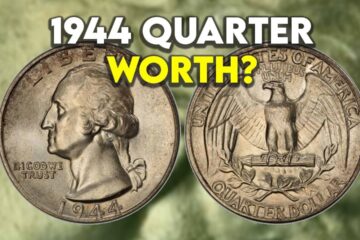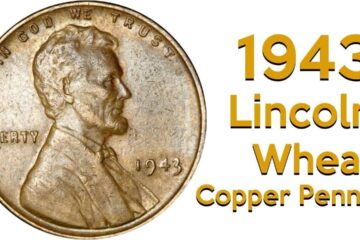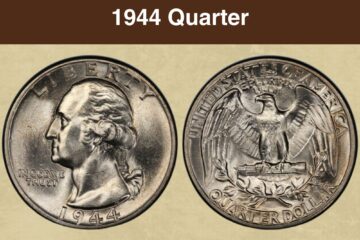The Indian Head penny was minted for half a century between 1859 and 1909 before it was eventually replaced by the Lincoln penny, the first US coin to bear the face of a US president.
Although its run ended more than a century ago, the Indian head penny holds a very special place in modern numismatics thanks to its rarity and historical significance.
In this article, we talk about a super rare penny worth great money. The 1909 penny variety is something you should know about. We will tell you what to look for and give you their most recent values.
This is especially true of the 1909 Indian Head penny, as this was both the last year of mintage of the coin and a year of relatively few mintages, as it was also the year in which the first Lincoln pennies were minted.

So if you’ve got your hands on a 1909 Indian Head Penny and are wondering what to do with it or thinking about adding one to your collection, here’s what you need to know about it.
| 1909 Indian Head Penny værdidiagram | ||||
| Like Mark | Gut | lived | Extremely fine | uncirculated |
| 1909 No mint mark Indian Head Penny Value | 4 to $7.20 | $7 to $14.40 | $15 to $40 | $46 to $7,250 and up |
| 1909 No Mintmark Proof Indian Head Penny Value | n/A | n/A | $110 to $1,110 | $700 to $18,000 and up |
| 1909 “S” Indian Head Penny Value | $235 to $312 | $315 to $510 | 500 $ bis 1.063 $ | $860 to $60,000 and up |
Although their face value was only one-hundredth of a dollar and they weren’t even made of silver or any other precious metal, 1909 Indian Head pennies can easily sell for thousands or even tens of thousands of dollars today. Of course, those that do must be of the highest possible physical quality, which usually means that they must never have been widely distributed.
But even those pennies that have seen some circulation but have still been kept in good condition can sell for hundreds of dollars or just over $1,000, especially if there is something particularly rare or significant about them.
1909 No mint mark Indian Head Penny Value

In 1909, unminted Indian Head pennies were produced by the Philadelphia Mint. In that year, as in the previous half-century, the Philadelphia Mint was the primary—and almost the only—U.S. mint producing these coins. So the lack of a mintmark, though it may seem extraordinary, was actually the norm for Indian head money.
The mintage of these coins in 1909 was relatively low for the series—only 14,368,470 regular coins plus a small number of proofs, which we will mention separately below. At the time, a circulation of only about 14 million cents was the lowest circulation produced in Philadelphia since 1885.
(Video) RAREST INDIAN HEAD PENNY OF ALL TIME, 1909 S PENNY COINS WORTH MONEY
Since the US Mint also made over 100 million Lincoln-PennysThis year—tthe first year Lincoln pennies were minted—tthe low numbers for the final Indian Head penny series are not surprising. In many other years and with many other coins, the minting would even have been stopped in the previous year.
Does all this mean that the unminted 1909 Indian Head penny is particularly rare? Not really. While 14 or so million coins is a smaller payout than usual, it’s still a pretty significant number. Also, the fact that unmarked Indian Head pennies were the norm for half a century means there were plenty of them, though mostly from different years.
So the only significant thing about this coin is that 1909 was the last year of its mintage. In every other aspect, from its components to its design, the immense 1909 Indian Head Penny is identical to most of its predecessors.
1909 Indian Head Penny Feature
To give you a brief overview of the design of this coin, when you first see a Native American head, it weighs only 3.11 grams, is 19mm in diameter, is 95% bronze with only some zinc or tin, and has a smooth edge.
Both the obverse and reverse of this coin were designed by James B. Longacre. The obverse shows Lady Liberty’s head facing left with a Native American headdress on top. Just below the head is the year of publication—in this case, 1909—and around it is simply “United States of America.”.
The back also has a fairly clean and simple design. In the center is the value of the coin “One Cent” in capital letters. This text is surrounded by a large oak wreath with three arrows tied to the underside. There is also a shield at the top of the coin, just above the text and between the two ends of the wreath.
The original 1859 version of the coin featured a laurel wreath without a shield, but the oak wreath and shield version was issued just a year later, making the design the norm for the Indian bounty coin.
So with all these factors mixed in, what is the value of a 1909 Indian head penny with no mint mark?
(Video) A super rare penny is worth money! 1909 penny variety to look for!
Although the coin had the standard pen design and there have been a few of these pennies over the years, the value of this 1909 Indian penny is still quite impressive. Even ordinary coins that have been in circulation and worn can sell for several dollars or over $10, which is technically 1,000 times the face value of the penny. This is despite the fact that it is also only made of bronze.
And when we start looking at better-quality pennies, we can see how quickly these prices rise into the tens, hundreds, and even thousands of dollars. Excellent-quality, unadorned 1909 Indian Head pennies can fetch upwards of $1,350 and $1,700 at auction today.
In some cases, these coins can even go into the 5-figure range, as was the case in 2023 when a 1909 MS 67 Indian Head penny was bought for $21,600.
1909 No Mintmark Proof Indian Head Penny Value

The Philadelphia Mint also produced a few Indian Head pennies in 1909—2,175 examples, to be exact. This number is so low that many people, when discussing the 1909 Indian Head penny, simply group the proofs with the Philly-made regular strikes, which is why you often find the number 14,370,645 instead of 14,368,470 for the variety above.
Nevertheless, polishing plates differ significantly from ordinary embossing, so they must be mentioned separately. If anything, the extra-small mintage of this proof makes these coins even more remarkable.
First, these 2,175 coins were made using a different technology than normal mint coins. The Philadelphia Mint used entirely separate proof dies that were acid-dipped and hand-polished to give these coins a much higher level of detail and accuracy.
After all, proof coins are intended for display purposes, as proof against counterfeiting, and as collector’s items; they are not intended for wide distribution like normal mint coins, even though they have the exact same design.
All of this means a few things: firstly, it is borderline impossible to find 1909 Indian head money of any quality less than Extremely Fine, as none of these coins were used as currency. Second, the value of even the most common 1909 Indian penny is estimated to be over $100 and often over $1,000.
(Video) RARE VALUABLE PENNIES WORTH MONEY INDIAN HEAD PENNY VALUE
This is especially true for ears with a mostly reddish or at least reddish-brown hue compared to predominantly brown proofs. This also applies to the normal mint coins as well as the S pennies, which we will discuss below. Depending on storage and handling, these bronze coins can turn a redder or browner color over the years, with the former being more valuable than the latter.
1909 “S” Indian Head Penny Value

The 1909 Indian Head pennies, bearing the San Francisco Mint’s “S” mintmark, are among the most valuable one-cent coins not just that year but ever. Although these coins are regular strikes and not proofs, they are often valued even higher than the 2,175 Philly proofs of 1909.
The reason for this is simple: rarity. In 1909, the San Francisco Mint produced a total of only 309,000 Indian Head pennies bearing the mint’s “S” mint mark.
This is, of course, a much higher number than the roughly 2,000 proof coins, but it was also only the second year that the 1909 San Francisco mint joined its Philadelphia counterpart in producing Indian Head money. The previous year was 1908, when the San Francisco Mint made $1,115,000.
This made the 309,000 “S” coins of 1909 the lowest mintage of common Indian head money in history. The only other Indian head penny mintage under one million was the unminted penny made in Philadelphia in 1877, which contained 852,500 coins—still considerably more than the 309,000 “S” coins in 1909.
This rarity, combined with the very rare ‘S’ coinmark of the Indian Head penny series, plus the fact that this was the last year of the series as a whole, as well as the fairly high quality of this year’s ‘S’ coins as a whole, meant in 1909 that Indian Head “S” pennies are incredibly valuable today.
Average prices for even sub-crowns today are in the hundreds of dollars and quickly rise into the thousands when looking at particularly high-quality coins. If you can find a graded and quality 1909 “S” Indian penny, you can easily expect it to sell for thousands or even tens of thousands of dollars.
The highest price we have seen for any of these coins is $97,750, which was paid for a 1909 Indian Head MS 67 “S” penny at a heritage auction in 2006.
1909 Indian Head Penny Grading
When it comes to coin grading in numismatics, you will often see grades from 1 to 70 followed by various combinations of two capital letters. The most common of these grading systems is the Sheldon coin scale, but there are similar ones.
(Video) Top 8 Most Valuable Indian Head Cents: Errors, Varieties, and Key Dates
The 1 to 70 scale typically refers to the character and visual quality of the coins, with anything below 50 usually not considered very good, and only coins above 60 and 65 considered “excellent” or “uncirculated.”. As for the letters before the numbers, they are usually additional qualifiers such as mint state (MS), proof (PR), and so on.
For some more visual examples of the 1909 penny grading with Indian heads, check out this cool video.
Listen to Indian Head Penny Errors from 1909
Interestingly, there are no known and significant Indian Head penny errors from 1909. This is especially true of the valuable 1909 “S” Indian Head penny, as the mintage of these coins was so small.
But even with coins without a mintmark, there is nothing worth noting about errors. Instead, all numismatists look at these coins for the presence or absence of a mint mark and their overall quality. As we have shown above, and as you can see in other videos like this one, the quality level is really the most important factor in the value of these coins.
1909 Indian Head Penny FAQ
What makes 1909 Indian Head Pennies so rare?
These coins are over a century old, they are from the last year of issue in this series, and some of them belong to either the small mintage series or the very special sub-series of the San Francisco Mint with the ‘S’ mint mark.
Is a 1909 Indian Head penny worth anything?
A 1909 Indian Head penny is almost always worth at least something, even if the coin is not in good condition and even if it is made entirely of bronze. So, especially if you find a better-quality coin, it will definitely be worth selling or even keeping, as its value will likely continue to increase in the future.
How much is a 1909-S VDB error penny worth?
According to estimates, a 1909 S VDB Wheat Penny is worth $950.00 in standard condition, whereas a penny in immaculate condition would be $4,150.00. A 1909-S VDB in MS 67 RD was acquired for $117,500 in 2014, breaking the previous record associated with this coin.
FAQ’s
How rare is a 1909 S Indian head penny?
The only rarities for the 1909-S Indian Head Cent are heavily worn pieces, as so few escaped detection long enough to wear down. Also somewhat scarce, though not truly rare, are fully red gems.
How much is a 1900 Indian head penny worth with no mint mark? ›
1900 Indian Head Penny Value for No Mint Mark (P) There are plenty of circulated 1900 Indian head pennies to go around, especially in good to very fine condition. There were also a handful of AU50 1900 Indian head pennies that were auctioned off in the early 2010s for anywhere from $15 to $38.
What is the rare penny with error?
“Double die pennies are highly sought after by coin collectors because they are considered a rare and valuable error. The double image on the coin makes it unique and highly prized among collectors.”
How do I identify a 1909-S VDB penny?
If you look at the mint mark below labeled “Parallel Mint Mark,” the two serifs point in the same direction vertically, in a parallel position. Genuine 1909-S VDB cents will have the VDB initials slightly slanted, specifically on the central crossbar of the letter “B.
What does a 1909-S VDB penny look like?
The 1909-S VDB penny is one of the most popular and valuable American coins. The coin was designed by Victor David Brenner, and it features a bust of Abraham Lincoln on the obverse and a wheat stalk on the reverse. The coin was minted at the San Francisco Mint in 1909, and only 484,000 were produced.
How many 1909-s pennies are left? ›
However, many in the public were aware of the controversy and hoarded 1909-S VDB pennies in large numbers. According to numismatic experts, some 20,000 specimens exist, making it a rarity that can be acquired for a cost.
How many 1909-S VDB pennies are there?
The 1909-S VDB Lincoln cent is considered to be a key date for the Lincoln cent series due to its low mintage of only 484,000.
How much is a 1909 VDB Indian Head Penny worth?
The USA Coin Book estimated value of the 1909 Lincoln Wheat Penny (VDB Variety) is $8.07 in average condition and can be $35 or more in uncirculated (MS+) mint condition. Proof coins can be worth $14,242 or more. Click here to learn how to use coin price charts. Also, click here to learn about grading coins.
What year is the rarest Indian head penny?
The most valuable Indian Head Penny is the one that has a date of 1877. Nevertheless, they’re all valuable in their own right, and any collector would be lucky to have one.
What are the most valuable non-error pennies?
The 1914-D Lincoln Wheat penny is another key date in the series and is the most valuable non-error penny. With a mintage of 1,193,000, it has one of the lowest mintages in the Wheat Cent series. It can be difficult to find uncirculated coins, as they are much more rare.
What is the rarest penny to look for?
Here’s a list of the top 7 most valuable pennies for 2023:
1) 1944 Steel Wheat Penny: $408,000.
2) 1943 Copper Wheat Penny: $250,000.
3) 1856 Flying Eagle Penny: $25,000.
4) 1873 Indian Head Penny: $10,000.
5) 1858 Flying Eagle Penny: $10,000.
6) 1857 Flying Eagle Penny: $7,000.
7) 1914 D Wheat Penny: $5,500.



